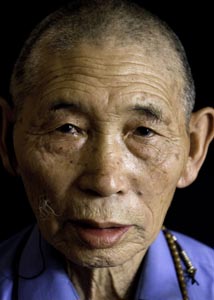Name: Thinley
(Alias: No)
Gender: Male
Interview Age: 81
Date of Birth: 1931
Birthplace: Dhakpo, Utsang, Tibet
Year Left Tibet: 1959
Profession: Servant
Monk/Nun: No
Political Prisoner: No

Interview No.: 9D
Date: 2012-05-16
Language: Tibetan
Location: Mcleod Ganj, Dharamsala, Himachal Pradesh, India
Categories: Buddhist Traditions
Keywords: Chinese -- first appearance of, Dalai Lama, March 10th Uprising, oracles, servitude, Utsang
Summary:
Thinley hails from Dhagpo in Utsang Province. His family was engaged in farming, but he does not recall much of village life because at the age of 13 Thinley was called to serve the monastery of the state oracle in Lhasa. He explains that in Tibet the land belonged to the government, monastery or aristocrats. The common people were subjects of these landowners and must serve in whatever capacity the owners requested or else pay a fine. This was the system of midhak 'master' and Thinley was assigned his service based on his father's master, the Nechung Monastery.
The Nechung Monastery was the monastery of the state oracle. Thinley describes in detail the institution of the Nechung, who is one of the main protector deities of Tibet and of the Dalai Lama. A kuten is the medium of the deity who transmits prophesies. Thinley talks about the Nechung's role in the Tibetan Government and other institutions. Thinley's job was to clean the living quarters of the kuten and he received a small salary in return.
Thinley recalls the final transmission that was sought of the Nechung oracle in the Norbulingka with Chinese troops surrounding the palace. The prophecy suggested that His Holiness the Dalai Lama to flee Tibet. The Nechung oracle and his staff soon left Lhasa as well and Thinley resumed his work in exile in Dharamsala. He served three different kuten over a span of 44 years.
Interview Team:
- Marcella Adamski (Interviewer)
- Tenzin Yangchen (Interpreter)
- Pema Tashi (Videographer)

